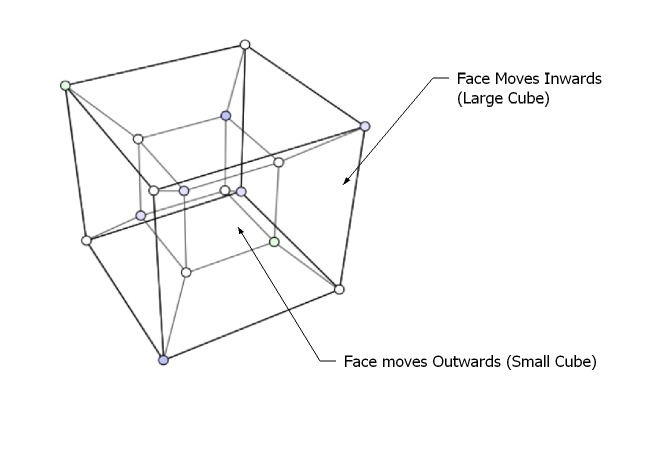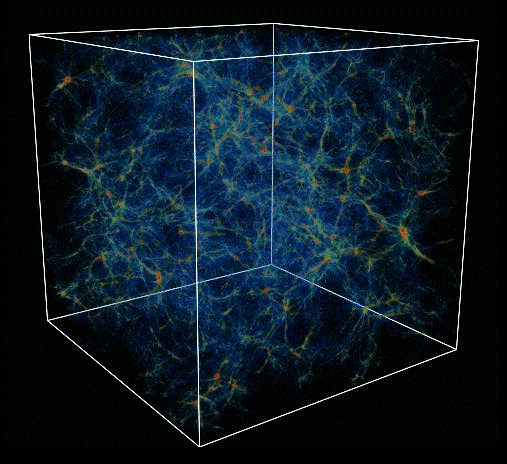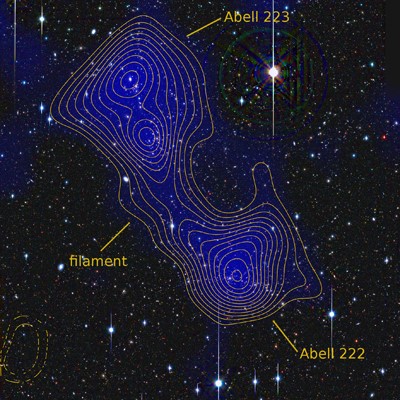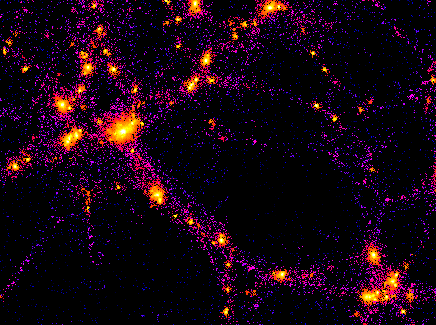
A possible explanation of how the Tesseract works and moves the Hero inside the Cube:
The Hero hits the Face of the Large Cube – The Cube detects the “Blue Matter” he carries and rotates in the fourth dimension. This causes the Large Cube Face
above to move Inwards, and the Small Cube face above to move Outwards. Because this happens in the fourth dimension (Space-Time) the smaller cube now becomes what
we would see as the outside of the original cube, because all the sides have the same dimensions in 3D. So, the Hero is still effectively on the surface of what
was the outer cube, but is now inside the cube visible on the moon. The cube visible on the moon that he landed on has not moved, changed size, and appears solid,
without the hero on it.
In the video, it mentioned Blue Matter that was extracted from a fragment of a cube.
This lead me to consider colour:
Wikipedia “Black” - Optics
In the visible spectrum, white reflects light and is a presence of all colors, but black absorbs light and is an absence of color.
Black can be defined as the visual impression experienced when no visible light reaches the eye. (This makes a contrast with whiteness, the impression of any
combination of colors of light that equally stimulates all three types of color-sensitive visual receptors.)
In physics, a black body is a perfect absorber of light, but, by a thermodynamic rule, it is also the best emitter. Thus, the best radiative cooling, out of sunlight,
is by using black paint, though it is important that it be black (a nearly perfect absorber) in the infrared as well. My understanding of black has always been the
opposite of white.
This made me consider: What if by adding or subtracting colours to/from white you could create black
Where Color is concerned:
Light Color The primary colors of *light* are red, blue, and green, and the secondary are yellow, cyan, and magenta.
Additive Color As stated previously, the primary colors of light are red, blue, and green. These occur in the *Additive Color (RGB) Model*, so named because black is the base and
light is "added" to eventually get to white, which is all of the colors together.
Subtractive Color The Subtractive Color (CMYK or CMY) Model is used for printed publications. There are only four colors that offset the printing process. The subtractive colors are
also the secondary colors in light: cyan, magenta, and yellow. Black is used in the subtractive model as well, because cyan, magenta, and yellow make more of a dark
gray than pure black when they are combined.
It also made me consider how you can travel across the universe by bending/folding space.
This involves two things Dark Matter and Dark Energy
Dark Matter:
Images of a “Dark Matter” Web



Over time, matter pulls together into a web-like structure along a scaffolding of dark matter (Illustration: left - Center for Cosmological Physics/U Chicago:
centre - Jörg Dietrich, University of Michigan/University Observatory Munich: right - Space 25 Feb 2010) The spindles you see are billions of galaxies clumped
and stretched together, called “filaments.” The dark spots are empty spaces containing nothing, called “voids”.
Dark energy
Dark energy makes up approximately 70% of the universe and appears to be associated with the vacuum in space. It is distributed evenly throughout the universe,
not only in space but also in time – in other words, its effect is not diluted as the universe expands. The even distribution means that dark energy does not
have any local gravitational effects, but rather a global effect on the universe as a whole. This leads to a repulsive force, which tends to accelerate the expansion
of the universe.
While dark energy repels, dark matter attracts. And dark matter’s influence shows up even in individual galaxies, while dark energy acts only on the scale of the
entire universe.
So:
If the Universe is connected by filaments of Dark Matter, with “Voids”, it roughly corresponds to a Spider’s Web. This web is expanding at a rate determined by
“Dark Energy”. Remember Dark Matter Attracts Dark Energy Repels
If Black is the total absorption of all colour, and White is all colours, could the “Blue Matter” in Catyph be only part of the “Dark Matter” which also makes the Cube?
If so, then can the Cube also give “Red Matter” and “Green Matter”? Can it also give Cyan, Magenta and Yellow matters?
If you view the cube as recognizing/detecting the “Blue Matter” used by the Hero, and the Cube absorbing all colour (when detected), does the hero need to locate/use
“Red, Green, Blue, Yellow, Cyan and Magenta Matter “to activate the Bigger Kunci? (i.e. he can make Dark Matter)
Can the Hero then use the “Filaments” between the galaxies (The Dark Matter Web) to transport himself anywhere in the universe (provided he has a map), using Dark Energy
to propel himself?
Or, like the Tesseract, does the Kunci work by using Dark Energy to fold The Dark Matter Web so that the Voids are aligned for the hero to travel between “fixed”
co-ordinates? (similar to a Wormhole).